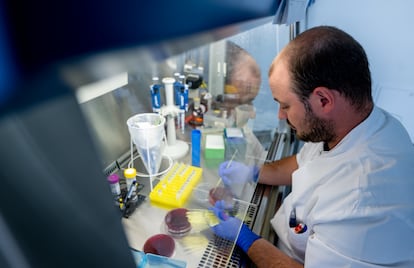Common bacterial infections are the second leading cause of death after heart disease
A study estimates that 33 common pathogens were behind one in eight of all infection-related fatalities in 2019

There is no such thing as a small enemy.
Barely 1.5 micrometers in size – a thousand times less than a millimeter – Staphylococcus aureus (or “Staph”) is capable of secreting toxins that cause food poisoning or internal infections that can easily kill a person.
This common bacterium is behind more than a million deaths each year. Along with 32 other common bacteria, it is a leading cause of global death, only second to heart disease. According to a study published on Monday, November 21 in The Lancet – the world’s leading medical journal – an estimated 7.7 million people died in 2019 due to common bacterial infections.
These bacteria are everywhere: in food, on surfaces, in our guts. They can be carried by animals or found gushing through tap water. While they are often harmless, they can sometimes produce serious infections that lead to conditions like sepsis – an uncontrolled, inflammatory response by the immune system to an infection – and cause damage to vital organs.
The scientists who authored the study looked at 33 microorganisms – both antibiotic-resistant and non-resistant – and 11 types of infections that can be caused by them, including ones related to the respiratory tract, bloodstream, or intestines.
Dr. Tomislav Meštrović, a professor at the Institute for Health Metrics and Evaluation at the University of Washington and main author of the study, justifies this selection of 33 bacteria in his research, as they “represent more than 80% of the deaths caused by all pathogens.”
“We think it was important to address this specific selection. We can clearly see that some of them have a comparable burden to the deadliest pathogens, but have not received the same attention.”
The study’s authors note that, in 2019, 13.7 million people worldwide died from some type of infection. Of these, more than half – 7.7 million – died as a result of one of the common bacterial infections included in the research.
If you get vaccinated against viral infections, you can reduce the risk of suffering a bacterial superinfection laterMaría del Mar Tomás, Spanish Society of Infectious Diseases
“There are many other important pathogens that are responsible for the high burden of infection-related deaths. HIV falls among the viral causes and malaria among the parasitic ones. However, we must keep in mind that there are approximately 1,400 known species of human pathogens that may contribute to the remaining deaths,” Meštrović points out.
The five most deadly bacteria included in the study are Staph, E. coli, Klebsiella pneumoniae, Pseudomonas aeruginosas and Streptococcus pneumoniae. These five microorganisms are behind 55% of all common bacteria-related deaths. They are also on the World Health Organization’s list of “priority bacteria” for research into new antibiotics, because they often exhibit resistance to medicine.
The authors acknowledge that their research has limitations, such as the scarcity of data in some countries, or the overestimation of the impact of certain pathogens.
“We cannot conclusively state that if all infections caused by these 33 pathogens were eliminated, that 7.7 million deaths could have been prevented,” the authors admit. Sometimes, they explain, the underlying cause of death is not the infection itself, but a health problem so serious that it can still lead to death.
“A person with terminal cancer who dies from E. coli is counted the same as a newborn who dies from E. coli,” the paper explains.
Geography often determines the risk threshold. The mortality rate is higher in Sub-Saharan African countries (230 deaths per 100,000 people) than in high-income countries, such as in Western Europe (52 deaths per 100,000 people).
The researchers say there are effective antimicrobials for all 33 bacteria investigated. Sadly, the disproportionately high burden in the poorest countries is attributed to “inadequate access to effective antimicrobials, weak health systems, or insufficient prevention programs.” The authors point to unaffordable drug prices, the inappropriate use of antibiotics due to lack of health education, as well as poor supply chains.
Jordi Vila, head of Microbiology at Hospital Clínic in Barcelona, emphasizes the necessity of improving the early identification of bacteria. “If you’re prescribing an antibiotic without knowing the [bacterial] cause of infection, it’s easier to make mistakes.”
Unfavorable living conditions – such as malnutrition, or difficulties in accessing clean water – bolster the strength of bacteria.
“Malnutrition is an immunodeficiency and, in such a case, a bacterium such as E.coli – which does not cause infection in a healthy child – can harm a malnourished child, once it penetrates the intestinal tissue,” Vila explains.
Staph was the deadliest common bacteria among people over the age of 15. Salmonella, meanwhile, is associated with the most deaths in children between the ages of five and 14. In the youngest children – those under four years of age – the great enemy is Streptococcus pneumoniae. For newborns, Klebsiella pneumoniae is the most dangerous.
The authors denounce the lack of global public health initiatives to tackle these deadly pathogens. They compare the situation with infectious diseases such as HIV, tuberculosis or tropical diseases, which – unlike common bacteria – have received “substantial investment.” On the other hand, they argue, to combat a bacterium like Staph, the only available funds are tied up to prevention in the surgical field and reducing antibiotic resistance.
“E. coli is associated with more deaths and years of life lost than tuberculosis… yet, it receives comparatively little public health care and minimal research funding,” the authors protest. A 2020 analysis of research funding for infectious diseases found that, between 2000 and 2017, HIV research received $42 billion. E. coli research, by comparison, obtained $800 million.
The authors are making a call to action for improved hospital programs and more community health education initiatives. In countries with fewer resources, they also propose improving “the management of malnutrition and the basic principles of access to clean water, sanitation and hygiene” to slow the spread and blunt the strength of common bacteria.
Rich countries, for their part, also have homework to do.
“In high-income countries, many infectious deaths are related to hospitalized patients and resistant microorganisms. There is always a need to improve hand hygiene in healthcare facilities, while prudent use of antimicrobial drugs and antimicrobial stewardship could help reduce the emergence and spread of resistant bacteria, both in hospitals and in the community.”
Another formula to reduce the burden of bacterial infections is vaccination.
“There is a shortage of vaccines in developing countries… the populations are unprotected,” Vila laments. The authors highlight the power of inoculations against other microorganisms, such as the influenza virus, which can facilitate subsequent bacterial superinfections.
María del Mar Tomás – spokesperson for the Spanish Society of Infectious Diseases – agrees on the need for vaccination campaigns and improved rapid diagnostic techniques:
“These bacteria are everywhere – it’s not difficult to come into contact with them. And, in sick or immunocompromised patients, they can cause infections. If you get vaccinated against viral infections, you can reduce the risk of suffering a bacterial superinfection later.”
The authors note that “high-income countries are also in a better position to develop vaccines that specifically target infectious agents.” Vila defends what is known as the “24/7″ approach:
“Microbiology laboratories need to have microbiologists and technical support on-call 24 hours-a-day, seven-days-a-week. Infections don’t understand schedules.”
Tu suscripción se está usando en otro dispositivo
¿Quieres añadir otro usuario a tu suscripción?
Si continúas leyendo en este dispositivo, no se podrá leer en el otro.
FlechaTu suscripción se está usando en otro dispositivo y solo puedes acceder a EL PAÍS desde un dispositivo a la vez.
Si quieres compartir tu cuenta, cambia tu suscripción a la modalidad Premium, así podrás añadir otro usuario. Cada uno accederá con su propia cuenta de email, lo que os permitirá personalizar vuestra experiencia en EL PAÍS.
¿Tienes una suscripción de empresa? Accede aquí para contratar más cuentas.
En el caso de no saber quién está usando tu cuenta, te recomendamos cambiar tu contraseña aquí.
Si decides continuar compartiendo tu cuenta, este mensaje se mostrará en tu dispositivo y en el de la otra persona que está usando tu cuenta de forma indefinida, afectando a tu experiencia de lectura. Puedes consultar aquí los términos y condiciones de la suscripción digital.
More information
Archived In
Últimas noticias
Most viewed
- Reinhard Genzel, Nobel laureate in physics: ‘One-minute videos will never give you the truth’
- Oona Chaplin: ‘I told James Cameron that I was living in a treehouse and starting a permaculture project with a friend’
- Pablo Escobar’s hippos: A serious environmental problem, 40 years on
- Why we lost the habit of sleeping in two segments and how that changed our sense of time
- Chevy Chase, the beloved comedian who was a monster off camera: ‘Not everyone hated him, just the people who’ve worked with him’











































